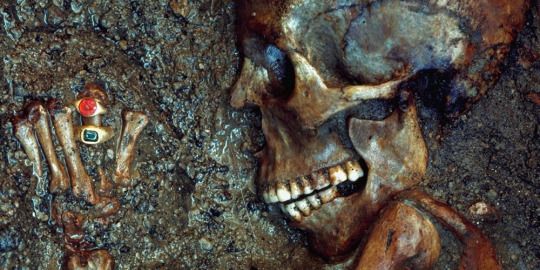The skeleton of this women was buried with a treasure of jewels
Before Mount Vesuvius erupted on August 24, in the year 79, according to most historians, Herculaneum had a population of about 5,000.
Because the entire town has not yet been excavated, that is a rough guess based on the size of the area where it sits and the size of the amphitheater. Excavations turned up practically nobodies until 1982 when the waterfront area was excavated.
Far from all the skeletons found in the city were found in the boathouses, shown in this photo. Others were found along the beach which would have been in the foreground.

Apparently the residents did what I would have done. If the volcano is erupting inland, I would run for the ocean and attempt to flee by boat.
There is no way of telling how many people successfully did this, but we can determine how many people did not make it. We didn’t get to tour the boathouses but from internet searches, it appears that many of the skeletons are still there (note in the first photo that some of the boathouses have tarps over their entrance).
One of the skeletons found on the beach included one that has been dubbed The Ring Lady. As can be seen in this photo, she had an emerald and a ruby ring on her fingers when she collapsed on the beach.

In addition, she had a purse that contained two gold bracelets with serpentine heads that met as well as two gold earrings that probably held pearls. These were likely her prized possessions that she was attempting to take with her.


Here is a close-up of the rings. Examination of her body shows that she was a tall 45-year-old woman in good health with good teeth but a bit of gum disease. She was likely knocked down by the pyroclastic blast and died immediately.
Another skeleton found on the beach was of a Roman soldier who collapsed, his fists clutching the sand. Every bone in his body except his inner ear was broken suggesting that he too was hit forcefully by the surge and knocked to the ground.
He was about 37 years old, wore a sword and bone-handled dagger by his side, and had a bag of carpenter’s tool on his back. Soldiers often worked in that trade. Fifteen silver coins and three gold coins were found near him, likely originally held in a cloth moneybag.
Anthropologist Sara Bisel examined the body and found that he had probably been a warrior for quite some time.
He was missing three front teeth (missing six teeth in total), had a mark on this thighbone where a prior wound had healed and had thick well-developed thighbones likely from frequent bareback horse riding as was common among soldiers of the era.
Roman soldier skeletons are a very rare find since the Romans usually cremated their dead.
